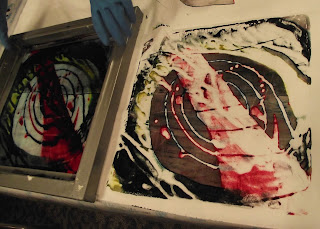Monday, September 2, 2013
Deconstructed Screen Printing
Vera did an interesting demo on deconstructed screen printing. She took a class in Portland, but the instruction was, here it is, do it. Vera is very technical about her dyeing, she makes samples and keeps records, to help her really understand the process. First dye was added to a print paste, made with sodium alginate, these different dye colors were put on a silk screen, in the pattern of your choice and left to dry. Vera brought a screen that was ready to use, and a large piece of PFD. A clear print paste is scraped through the screen, "deconstructing" the design. As the paste reacts with the dry dyed paste, the dye leaches onto the fabric. The first print was light, and successive prints were darker, you can make as many prints as you can, until there is no dye left on the screen. She used a plastic "Bondo" spreader from Napa Auto parts to spread the dye paste. Vera overprinted the first light print, rotating the screen 90 degrees. The second process was the reverse of the first. She painted a pattern on the silk screen with clear dye paste, and let it dry. The dry paste acts as a resist for the colored dye paste. Then she used a dye/paste to print the screen onto fabric. She printed her rust fractured design on previously dyed fabric. Lastly, Vera had a whole set of treated fabric samples, that she is using different types of resist on. Each resist has different qualities and uses for dyeing. Potato dextrin, gives a crackle effect, tape and corn dextrin give crisper images, sugar syrup was a softer image, and school glue gave a fine line for writing, but was difficult to remove. It will be interesting to see these samples after she has dyed them. It will be a good learning experience for all of us, without us having to go to all the work that Vera is doing. Thank you Vera for an excellent demonstration, we look forward to the next dye workshop.
Subscribe to:
Post Comments (Atom)







No comments:
Post a Comment